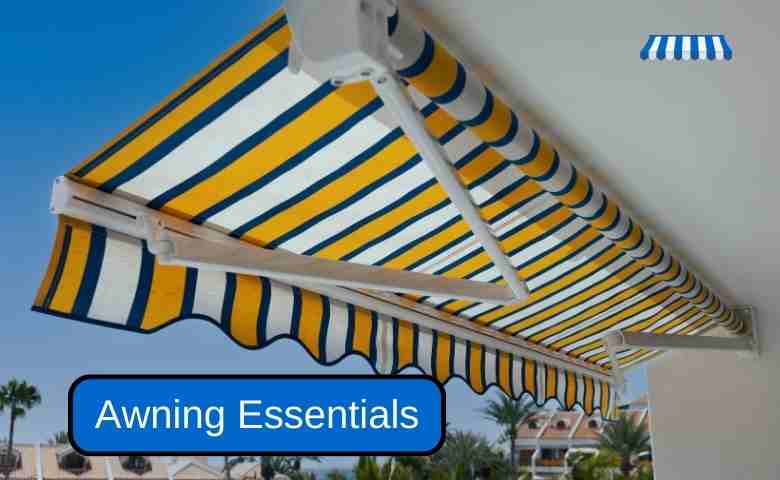Last Updated on February 19, 2025 by Admin
Outdoor living spaces have evolved from simple patios into dynamic, multi-functional extensions of your home. In 2025, awnings will become a must-have element for homeowners seeking to combine style, functionality, and sustainability. Whether you’re looking to create a cozy retreat, enhance energy efficiency, or simply add a splash of personality to your façade, understanding awning essentials is key. This ultimate guide covers everything you need to know—from the benefits and latest trends in awning technology to maintenance tips and smart integration strategies.
Table of Contents
Why Awnings Matter in Modern Outdoor Living
Awnings are more than just a shield from the sun—they’re a transformative design element that elevates your outdoor space. With increasing emphasis on outdoor living in 2025, homeowners are investing in awnings to:
- Provide Comfort and Shade: By reducing direct sunlight, awnings keep patios cool and comfortable during hot summer days. This improves energy efficiency by lowering cooling costs indoors.
- Enhance Aesthetic Appeal: With modern designs that range from bold, vibrant colors to minimalist, sleek lines, awnings add an instant upgrade to your home’s exterior.
- Increase Property Value: A well-designed outdoor space that includes functional awnings can significantly boost your property’s curb appeal and market value.
- Expand Living Areas: Awnings create additional usable space, allowing you to host outdoor gatherings, dine alfresco, or simply relax in a serene environment.
As more homeowners embrace outdoor living, awnings have become essential for creating a balanced, stylish, and functional home environment.
Understanding Different Types of Awnings
Before diving into trends and advanced features, it’s important to understand the basic types of awnings available today. Each type offers unique benefits and is suitable for various applications.
1. Retractable Awnings
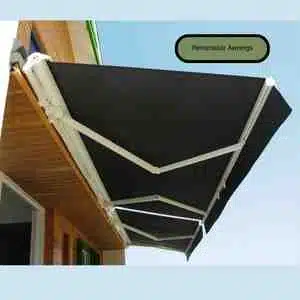
Retractable awnings are highly popular because they offer flexibility. With the simple push of a button or a manual crank, you can extend or retract the awning based on your needs. Ideal for patios, decks, and windows, these awnings allow you to control sunlight exposure and quickly adapt to changing weather conditions.
2. Fixed Awnings
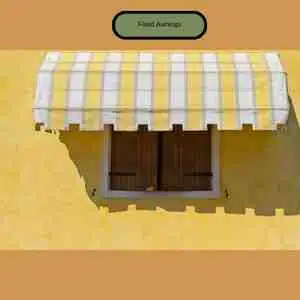
Fixed awnings provide a permanent solution and are excellent for year-round protection. They’re typically mounted above windows or doorways, adding architectural interest while protecting interiors from UV rays and rain. Their durability makes them a long-term investment in both style and functionality.
3. Motorized Awnings
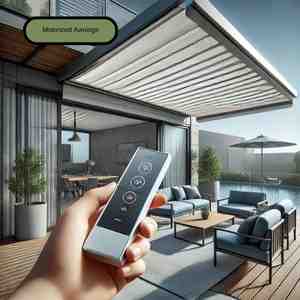
An upgrade on retractable awnings, motorized awnings come with automated features, including remote control and smart technology integration. These awnings can adjust automatically based on weather conditions, ensuring optimal protection and convenience.
4. Patio Awnings and Canopies
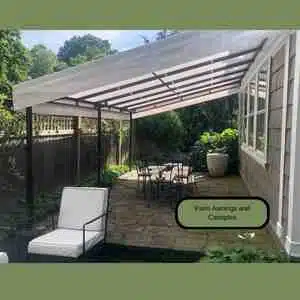
For expansive outdoor spaces, patio awnings and canopies are ideal. They can cover large areas, providing a defined space for outdoor dining, lounging, or entertainment. These structures can be custom-designed to match your home’s aesthetic, offering both practicality and visual appeal.
Understanding these different types helps you choose the perfect awning solution tailored to your specific outdoor needs.
The Latest Trends in Awning Technology for 2025
As we move further into 2025, awning technology is witnessing rapid innovations that are reshaping the outdoor living experience. Here are some of the top trends to watch:
1. Bold Colors and Contemporary Patterns
Gone are the days when awnings were limited to neutral or earth tones. This year, bold hues like canary yellow, royal blue and crimson red are making a statement. Modern patterns—from geometric prints to artistic stripes—are being embraced to add a splash of personality to facades and patios. Homeowners are increasingly opting for custom-designed awnings that not only complement their home’s exterior but also serve as a focal point in outdoor design.
2. Sustainable Materials
Sustainability remains at the forefront of design trends. In 2025, many manufacturers will be offering awnings made from eco-friendly materials such as recycled polyester, organic cotton blends, and sustainable wood alternatives. These materials not only minimize environmental impact but also enhance durability and weather resistance. Using sustainable options supports eco-conscious living and positions your home as modern and forward-thinking.
3. Enhanced Automation and Smart Features
The integration of smart technology in awnings is revolutionizing their functionality. Many modern awnings now feature remote-controlled operation, voice commands, and sensor-driven automation. For example, some motorized awnings automatically retract during high winds or heavy rain, protecting your investment without manual intervention. Additionally, cloud-based connectivity allows you to control your awnings from anywhere via smartphone apps—a trend that caters to today’s tech-savvy homeowners.
4. Multifunctional and Versatile Designs
Homeowners want awnings that do more than just provide shade. Multifunctional awnings are being designed to integrate seamlessly with outdoor furniture, lighting, and even heating systems. For instance, retractable awnings can be paired with integrated LED lighting to create ambient settings for evening gatherings. Similarly, some awnings now offer built-in heating elements, making them ideal for year-round use.
5. Customization and Bespoke Options
Personalization is key in 2025. Homeowners are no longer satisfied with off-the-shelf solutions. Customization options now include adjustable fabric tension, bespoke color matching, and tailor-made sizes to perfectly fit unique architectural features. This trend allows you to create an outdoor space that reflects your personal style and meets your practical requirements, ensuring that your awning is both a functional addition and a design statement.
These trends indicate that awnings in 2025 are not just about function—they are also about making an aesthetic impact while providing modern conveniences. The future of awnings is bright, innovative, and sustainable.
Sustainable and Eco-Friendly Awning Options
Sustainability isn’t just a buzzword—it’s a necessity in today’s design world. Eco-friendly awning options are gaining traction, and here’s why they should be at the top of your list when planning your outdoor transformation.
Eco-Friendly Fabrics and Materials
Manufacturers are increasingly opting for recycled and sustainable materials. Look for awnings crafted from recycled polyester or fabrics made from organic cotton blends. These materials are designed to reduce environmental impact while providing excellent durability and UV protection. In addition to fabric innovations, frame materials like anodized aluminum and sustainably sourced wood offer strength and longevity without compromising on eco-friendly values.
Energy Efficiency and Reduced Carbon Footprint
Awnings play a significant role in improving your home’s energy efficiency. By blocking harsh sunlight, they keep indoor temperatures lower and reduce the need for air conditioning, which in turn minimizes energy consumption. Some modern awnings are even designed with reflective coatings that further enhance their cooling properties. This eco-friendly feature not only helps the environment but can also lead to significant savings on your energy bills.
Low Maintenance and Longevity
Eco-friendly awnings are typically designed with low maintenance in mind. Advanced materials resist fading, mold, and mildew, meaning they look great for years with minimal upkeep. Long-lasting performance is a key benefit of investing in sustainable awning options, ensuring that your outdoor living space remains inviting and attractive season after season.
By choosing sustainable awning options, you are making a conscious decision to support eco-friendly practices and contribute to a greener future—all while enjoying a stylish, modern outdoor space.
Smart Integration: Motorized & Automated Awnings
The rise of smart technology has transformed the way we interact with our outdoor spaces. In 2025, motorized and automated awnings are taking center stage, offering unparalleled convenience and control.
The Benefits of Motorized Awnings
Motorized awnings are designed with convenience in mind. With integrated motors, these awnings can be extended or retracted at the touch of a button. Imagine adjusting your outdoor shade without leaving the comfort of your chair—a perfect blend of luxury and practicality. Some models even feature remote control or smartphone app integration, allowing you to manage your awning settings from anywhere in the world.
Weather Sensors and Automation
One of the most innovative features in modern awnings is the inclusion of weather sensors. These sensors detect wind speed, temperature, and rainfall, automatically retracting the awning when conditions become unfavorable. This smart functionality not only protects your awning from damage but also provides peace of mind during unexpected weather events. Additionally, automation systems can be programmed to adjust the awning throughout the day, optimizing shade and comfort based on real-time weather data.
Integration with Smart Home Systems
In today’s connected world, compatibility with smart home systems is a game-changer. Many motorized awnings can now be integrated with home automation platforms like Alexa, Google Home, or Apple HomeKit. This integration allows for voice commands and seamless control, making it easier than ever to tailor your outdoor living experience to your lifestyle. Whether you’re planning a family barbecue or a quiet evening under the stars, smart awnings enhance your comfort and convenience.
The integration of smart technology in awnings represents the future of outdoor living, combining functionality with cutting-edge innovation to create a truly modern experience.
Enhancing Your Outdoor Living Space with Awnings
Awnings are not just standalone features—they are integral to transforming your outdoor living space into an extension of your home. Here’s how to make the most of your awning investment.
Creating a Seamless Indoor-Outdoor Connection
A well-designed awning can blur the lines between indoor and outdoor spaces. By installing awnings over patios, decks, or large windows, you create an inviting transition area that encourages you to spend more time outdoors. This design strategy not only enhances the aesthetic appeal of your home but also increases usable space, perfect for entertaining guests or enjoying family time.
Defining Zones and Creating Ambiance
One of the key benefits of awnings is their ability to define distinct zones within your outdoor area. For example, a retractable awning can cover your dining area, providing shade during the day and creating an intimate atmosphere for evening meals with integrated lighting. Similarly, installing an awning over a lounge area can create a comfortable retreat where you can relax, read, or simply enjoy the fresh air.
Complementing Outdoor Furnishings and Decor
When selecting an awning, consider how its color, style, and texture will work with your existing outdoor décor. Bold awning colors can serve as a statement piece, while more neutral tones provide subtle elegance that complements any design. Pair your awning with weather-resistant outdoor furniture, vibrant planters, and creative lighting to build a cohesive and inviting outdoor space.
Increasing Privacy and Security
Awnings also offer practical benefits by enhancing privacy and security. For example, fixed or retractable awnings can shield your windows from prying eyes while reducing glare and UV exposure. This dual functionality not only boosts comfort but also contributes to energy efficiency by keeping your home cooler during the hottest parts of the day.
By thoughtfully integrating awnings into your outdoor design, you can create a space that is both functional and beautiful—a true extension of your indoor sanctuary.
DIY vs. Professional Awning Installation
When it comes to installing awnings, homeowners face a choice between DIY installation and hiring professionals. Both options have their advantages and challenges, so it’s important to consider your skills, budget, and the complexity of your project.
DIY Awning Installation
For those who are handy and enjoy home improvement projects, DIY installation can be an attractive option. Many modern awnings come with detailed instructions and user-friendly mounting systems that make installation relatively straightforward. DIY projects can be more cost-effective and provide the satisfaction of a job well done. However, it’s essential to have the proper tools and to follow safety guidelines carefully to avoid damage or injury.
Hiring Professional Installers
On the other hand, professional installation offers peace of mind and expert craftsmanship. Professional installers have the experience and equipment necessary to ensure that your awning is mounted securely and functions optimally. This option is particularly recommended for motorized or custom-designed awnings where precise alignment and integration with other systems (like smart home technology) are critical. Although professional installation may come at a higher upfront cost, it can save you time and prevent potential headaches down the road.
Factors to Consider
- Budget: DIY projects can lower costs but require time and effort. Professional installation may be more expensive but offers expertise and warranty protection.
- Complexity: For large or technologically advanced awnings, professional help is often advisable.
- Time: Consider how quickly you want your outdoor space transformed. Professionals typically complete installations faster and with fewer complications.
Ultimately, the choice depends on your individual needs and comfort level with home improvement projects. Whether DIY or professionally installed, the key is to ensure that your awning is safe, secure, and perfectly integrated with your outdoor design.
Maintenance and Care for Long-Lasting Performance
Awnings are an investment in your home’s comfort and style, and proper maintenance is crucial to ensure they last for years. Here are some essential maintenance tips to keep your awning in top condition:
Regular Cleaning
Dirt, dust, and debris can accumulate on awnings over time, affecting their appearance and performance. Clean your awning regularly with a mild soap solution and a soft brush or cloth. Avoid harsh chemicals that may damage the fabric or finish. For motorized awnings, ensure that the control system remains free of dust and moisture.
Inspecting for Wear and Tear
Periodically inspect your awning for signs of wear, such as fraying, fading, or damage to the mounting hardware. Early detection of issues like loose screws or fabric tears can prevent costly repairs later. For retractable and motorized awnings, inspect the mechanisms and motors to ensure smooth operation.
Reapplying Protective Coatings
Many awning fabrics come with UV-protective coatings that may diminish over time. Check the manufacturer’s recommendations for reapplying protective treatments to extend the life of the fabric. This maintenance step is especially important in areas with high sun exposure.
Seasonal Adjustments
In climates with harsh winters or heavy rains, it’s wise to retract or remove your awning during extreme weather to prevent damage. Consult your awning’s manual for guidelines on seasonal adjustments, including proper storage techniques if the awning is removable.
Professional Servicing
Even with routine DIY maintenance, having a professional inspect your awning every couple of years can ensure that all components are in optimal condition. Professional servicing may include lubrication of moving parts, tightening of fixtures, and detailed cleaning of both the fabric and structure.
Taking care of your awning not only preserves its aesthetic appeal but also ensures that it continues to provide reliable performance throughout its lifespan. With regular maintenance, your awning will remain a cornerstone of your outdoor living space for many years to come.
Design Inspiration and Creative Ideas
If you’re looking for inspiration to truly transform your outdoor living space, consider these creative ideas to make your awning a standout feature:
1. Layered Outdoor Spaces
Create depth and dimension by layering different outdoor zones. Use retractable awnings to define a dining area, a lounge space, and even a mini outdoor bar. This multi-level approach ensures that every area has its own character while remaining connected.
2. Integrate Lighting
Enhance the ambiance of your outdoor space by integrating LED or smart lighting into your awning design. Whether you choose string lights draped along the edge or built-in LED strips, lighting can set the mood for evening gatherings and add a dramatic flair to your outdoor décor.
3. Bold Color Accents
Don’t shy away from color—make your awning the centerpiece of your outdoor design with bold hues that complement your home’s exterior. Consider pairing a vibrant awning with neutral furniture and greenery to create a balanced, eye-catching look. Custom printed fabrics with unique patterns can also add a personalized touch.
4. Combining Materials
Mix and match materials for a modern, eclectic look. For example, pair a sleek, motorized awning with natural wood accents or stone details in your patio. This blend of contemporary technology and organic materials creates a dynamic environment that is both stylish and inviting.
5. Seasonal Themes
Transform your outdoor space throughout the year by switching accessories and décor based on the season. In the summer, use bright, cheerful cushions and tropical plants; in the fall, incorporate warm-toned blankets and rustic decor. Awnings serve as a versatile backdrop that adapts to every season’s vibe.
6. Outdoor Art and Murals
Consider incorporating outdoor art or murals under your awning to create a unique focal point. From custom-painted designs to metal sculptures, art adds character and reflects your personal style. This approach is especially effective in transforming a plain patio into a vibrant outdoor retreat.
7. Functional Add-Ons
Think about how your awning can serve multiple functions. For instance, some designs include integrated heating elements, fans, or even retractable screens for privacy. These add-ons not only boost functionality but also make your outdoor space more comfortable year-round.
With endless creative possibilities, your awning can become the canvas for a personalized outdoor living space that reflects your lifestyle and aesthetic preferences. Draw inspiration from current trends and don’t hesitate to experiment with different styles until you find the perfect look for your home.
Conclusion: Transform Your Space Today
In 2025, awnings are at the forefront of outdoor design innovation. They offer an elegant solution to enhance comfort, energy efficiency, and aesthetic appeal in your outdoor living space. From the latest trends in bold colors, sustainable materials, and smart technology integration to the practical benefits of increased shade and defined outdoor zones, awnings have the power to transform your home.
Whether you opt for a retractable model that offers flexibility or a fixed awning that delivers year-round protection, incorporating awning essentials into your design will elevate your outdoor experience. With the right planning, installation, and maintenance, your awning will not only protect your home from the elements but also serve as a stylish focal point that enhances your overall property value.
If you’re ready to embrace the future of outdoor living, start by exploring your options, considering the latest trends, and envisioning the perfect space for your lifestyle. Whether you choose a DIY project or professional installation, remember that your awning is an investment in comfort, sustainability, and style. Transform your outdoor living space into a luxurious retreat that you and your family can enjoy for years to come.
Take the first step towards creating your dream outdoor space today. With innovation, creativity, and a focus on sustainable design, awning essentials offer a practical and beautiful solution to reimagine your home’s exterior. Let your outdoor living space be a testament to modern design—functional, dynamic, and unmistakably you.
Embrace the power of awnings in transforming your outdoor space and join the growing number of homeowners who have discovered that the perfect blend of technology, style, and sustainability can make every day feel like a vacation. Explore different styles, invest in smart features, and let your awning serve as the gateway to a stunning, comfortable, and energy-efficient outdoor retreat.
Ready to transform your outdoor living space? Start planning your project now, and in 2025, you will experience the unmatched benefits of modern awning solutions.
Related Posts:
- Maximizing Your Outdoor Space: Tips for Selecting the Perfect Furniture
- Transform Your Patio: Creative Outdoor Living Space Ideas
- Transforming Construction: The New Horizon of Careers in Construction Technology Integration
- Essential Tips for Estimating Patio Renovation Costs
- How Technology is Transforming the Architectural Landscape
- Al Fresco All Year: How to Create an Outdoor Kitchen Oasis Regardless of Climate


